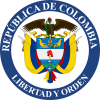Camilo Torres Tenorio
Camilo Torres Tenorio | ||
|---|---|---|
Vice President Manuel Rodríguez Torices | | |
| Preceded by | Triumvirate Manuel Rodríguez Torices, Antonio Villavicencio, José Miguel Pey de Andrade | |
| Succeeded by | José Fernández Madrid | |
| Personal details | ||
| Born | November 22, 1766 Universidad Santo Tomás | |
| ||
José Camilo Clemente de Torres Tenorio (November 22, 1766 – October 5, 1816) was a Colombian politician. He is credited as being an early founder of the nation due to his role in early struggles for independence from Spain.[1]
Biography

Torres was born in
Torres married María Francisca Prieto y Ricaurte in 1802 in Bogotá. They had six children.[3]
Torres was part of a generation that had witnessed the Insurrection of the Comuneros in 1781, and had experienced the independence of the United States in 1776 and the French Revolution in 1789. Antonio Nariño had translated into Spanish the "Declaration of the Rights of Man" in 1794, and had spread the influence of these ideas all throughout Latin America. This translation led to Nariño being exiled, and many of the students in the Colegio del Rosario were in turn persecuted, including Torres.
With the abdication of

The dissolution of the
Meanwhile, king
After his death, all of his possessions were confiscated and his family was stranded in poverty. When Bolívar became president he decided to support them by donating part of his own stipend every month. Camilo Torres' face has appeared in the $2 and $50 Colombian peso banknotes.
References
- ISBN 9781412821520.
- ^ a b "Camilo Torres - Enciclopedia | Banrepcultural". enciclopedia.banrepcultural.org. Retrieved 2019-09-10.
- ^ a b c "Camilo Torres Tenorio | Real Academia de la Historia". dbe.rah.es. Retrieved 2019-09-10.
- ^ "El Memorial de Agravios". Señal Memoria (in Spanish). Retrieved 2019-09-10.
- ^ Lleras de la Fuente, Carlos (1959). "Camilo Torres y el memorial de agravios". Boletín Cultural y Bibliográfico. 2: 10–11.

